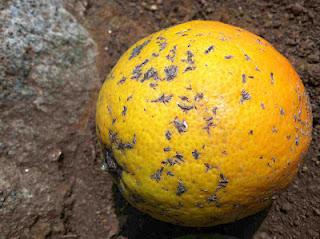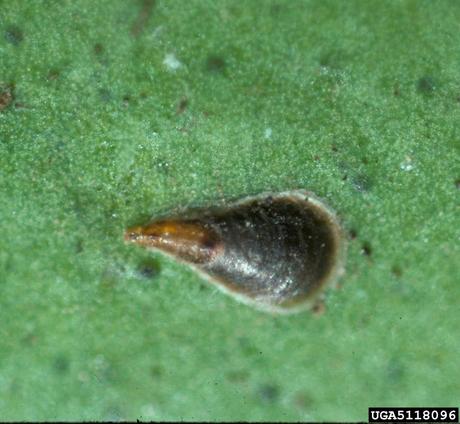I am tickled to death that my name has gotten around the internet as much as it has. Now mind you, I live in North Charleston, South Carolina. I got an e-mail from a very nice guy out in San Diego, California. He came across my name and blog trying to diagnose what he thought was a very serious problem. He was afraid that he had Citrus Scab.
Just so you know, Citrus scab, which is caused by the fungus Elsinoe fawcetti, affects the fruit, leaves, and twigs of susceptible varieties of citrus. It can be particularly severe on lemons, Temples, and Murcotts and on Minneola tangelos. It is often a problem on grapefruit, but rarely occurs on round oranges. Sweet orange is generally only infected if trees are located very close to infected trees of other varieties. His problem was on a Valencia Sweet orange. Never underestimate the information that somebody is trying to get when diagnosing a problem, it being a Valencia was VERY important here.
Anyway, this is the picture that he sent me:

I want to be honest here. I knew it was not Citrus Scab, but I did contact a couple of my Citrus buddies to make sure we had a positive ID.
It turned out to be Lepidosaphes beckii, Citrus Mussel Scale. This type of scale also goes by the names, Purple Scale, Orange Scale, Comma Scale and Mussel Purple Scale. This scale is highly specific to Citrus, rarely to never being found on any other plant.
This is one of the most destructive insect pests of Citrus throughout the world. The small insects attach themselves to leaves, fruit, and small branches causing injury by sucking the tree's sap. It is of Oriental origin, which makes sense because Citrus is of Oriental origin. It poses major problems for Citrus in Central and South America, South Africa, Australia, Hawaii, Florida, Texas and California.
If you put a magnifying glass to this pest, it would look like this:

Photo courtesy of University of Georgia
The 1/8 inch adult female lays eggs under its mussel-shaped scale and up to four generations may occur annually. Damage to fruit occurs in heavy infestations, where spotting and often deformity of fruits affects market value. Areas surrounding scales remain green long after the rest of the fruit ripens. Another good way to tell if you have a problem is, if there are ants having a big old parade up and down your tree, start watching for scale. Ants feed on the sugar secretion that scale puts out. They also often defend scale insects from predators and parasites.
Control is difficult. That coat of armor that they wear protects them from most insecticides. Scale insects are most vulnerable at juvenile or ‘crawler’ stage; however they are also very difficult to see. The use of a horticultural oil is your best bet. Ideally, good spray coverage during plant dormancy or when crawlers are active is the key to successful control of scale. Bark as well as foliage should be treated.
Trees that do not have a dormancy period i.e. citrus are best treated when crawlers are active in Spring and again at the end of Summer. Spot treatments may also be required until infestation is under control. It may take 2 to 3 years before the infestation is properly managed and the affected tree shows signs of recovery.
There are some natural enemies of scale, they include parasitical wasps, lady beetles, spiders, lacewigs and predatory mites. Small birds also feast on scale. Beneficial insects can be bought and released to control scale. You might want to remember that beneficials will die if released onto leaves that have been treated with insecticide.
For my e-mail friend in San Diego he was relieved it was not Scab, However it sounded like he had a pretty bad infestation.......His work has just begun.
Happy Growing!
Darren

